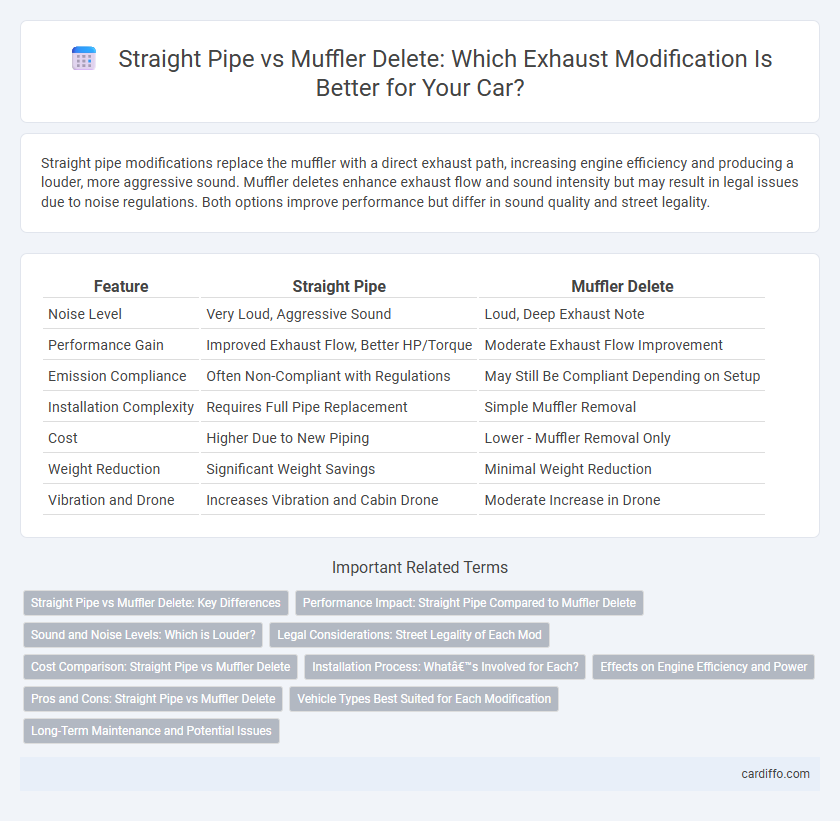Straight pipe modifications replace the muffler with a direct exhaust path, increasing engine efficiency and producing a louder, more aggressive sound. Muffler deletes enhance exhaust flow and sound intensity but may result in legal issues due to noise regulations. Both options improve performance but differ in sound quality and street legality.
Table of Comparison
| Feature | Straight Pipe | Muffler Delete |
|---|---|---|
| Noise Level | Very Loud, Aggressive Sound | Loud, Deep Exhaust Note |
| Performance Gain | Improved Exhaust Flow, Better HP/Torque | Moderate Exhaust Flow Improvement |
| Emission Compliance | Often Non-Compliant with Regulations | May Still Be Compliant Depending on Setup |
| Installation Complexity | Requires Full Pipe Replacement | Simple Muffler Removal |
| Cost | Higher Due to New Piping | Lower - Muffler Removal Only |
| Weight Reduction | Significant Weight Savings | Minimal Weight Reduction |
| Vibration and Drone | Increases Vibration and Cabin Drone | Moderate Increase in Drone |
Straight Pipe vs Muffler Delete: Key Differences
Straight pipe modifications replace the entire exhaust system with a single diameter pipe, resulting in maximum exhaust flow and increased engine performance. Muffler delete specifically removes the muffler but retains the rest of the stock exhaust system, maintaining some restriction while amplifying sound output. The key differences lie in sound intensity, backpressure reduction, and emission control, where straight pipes deliver louder, freer-flowing exhaust but may impact legal compliance more than muffler deletes.
Performance Impact: Straight Pipe Compared to Muffler Delete
Straight pipe modifications eliminate mufflers and catalytic converters, reducing backpressure to enhance engine airflow, which can improve horsepower and throttle response. Muffler delete retains the catalytic converter but removes mufflers, resulting in a moderate increase in exhaust flow and a more aggressive sound without significant power gains. Performance impact of a straight pipe is generally more pronounced due to greater exhaust flow improvements compared to a muffler delete, but it may increase emissions and noise levels.
Sound and Noise Levels: Which is Louder?
Removing the muffler from a straight pipe increases sound volume significantly, often exceeding 90 decibels, compared to the muffler-equipped system which typically remains below 75 decibels. Straight pipes produce a sharper, more aggressive exhaust note due to unrestricted gas flow and minimal sound dampening. Noise regulations frequently restrict the use of straight pipes on public roads because of their elevated noise levels and potential to cause hearing damage.
Legal Considerations: Street Legality of Each Mod
Straight pipe modifications often result in louder exhaust noise and increased emissions, which may violate local noise ordinances and environmental regulations, making them illegal for street use in many areas. Muffler delete mods similarly amplify exhaust sound and can fail emissions tests required for vehicle registration, leading to potential fines or failed inspections. Vehicle owners should verify state and municipal laws before performing either modification to ensure compliance with street-legal requirements.
Cost Comparison: Straight Pipe vs Muffler Delete
Straight pipe modifications generally cost between $100 to $300, offering a more affordable alternative to muffler deletes, which range from $200 to $500. Straight pipes reduce backpressure more effectively, improving exhaust flow but may produce louder noise compared to muffler deletes. Maintenance costs for straight pipes tend to be lower due to fewer components, while muffler deletes might require additional work to prevent rattling or vibrations.
Installation Process: What’s Involved for Each?
Installing a straight pipe involves removing the factory catalytic converter and muffler, then welding or clamping a straight section of pipe in place, which generally requires precision cutting and alignment for a proper fit. Muffler delete installations require detaching the muffler and replacing it with a straight section of pipe or a resonator pipe, often involving cutting, welding, and ensuring the pipe diameter matches the exhaust system to maintain airflow. Both modifications demand metal cutting tools, welding equipment, and mechanical expertise to ensure secure, leak-free connections and compliance with local emissions regulations.
Effects on Engine Efficiency and Power
Straight pipe modifications reduce exhaust backpressure, allowing exhaust gases to exit more freely, which can increase engine efficiency and horsepower, especially at higher RPMs. Muffler deletes eliminate sound-dampening components, resulting in similar gains in power but often at the cost of increased noise and potential emissions issues. However, straight pipe setups generally maintain better exhaust flow dynamics compared to muffler deletes, optimizing both engine performance and efficiency.
Pros and Cons: Straight Pipe vs Muffler Delete
Straight pipe modifications enhance exhaust flow, increasing horsepower and producing a louder, more aggressive sound, but they may cause drone and fail emissions tests due to lack of noise and particulate filtering. Muffler deletes also amplify exhaust noise and improve flow, however, they retain some exhaust system components, often resulting in a less intense sound compared to straight pipes and potentially less impact on back pressure. Both approaches can improve performance but may lead to legal issues depending on local noise and emission regulations, with straight pipes generally offering maximum flow and muffler deletes providing a middle ground between sound and compliance.
Vehicle Types Best Suited for Each Modification
Straight pipe modifications are best suited for performance-oriented vehicles such as sports cars and motorcycles where reducing exhaust backpressure is a priority to maximize horsepower and engine responsiveness. Muffler delete setups benefit trucks and off-road vehicles that require louder exhaust notes and easier exhaust flow to enhance engine torque and sound customization. Each modification caters to specific vehicle types by balancing noise level, emissions, and power output according to intended usage and local regulations.
Long-Term Maintenance and Potential Issues
Straight pipe modifications reduce backpressure and can improve engine performance but often lead to increased noise and potential legal issues due to emissions non-compliance. Muffler delete removes the muffler, enhancing exhaust sound but typically causes faster wear on exhaust components and may result in excessive noise, attracting fines or inspections. Both modifications demand frequent monitoring for leaks, rust, and sensor malfunctions to ensure long-term reliability and avoid costly repairs.
straight pipe vs muffler delete Infographic

 cardiffo.com
cardiffo.com